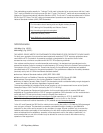
178 4B. Regulatory Notices
This methodology applies equally for T ratings. The M mark is intended to be synonymous with the U mark.
The T mark is intended to be synonymous with the UT mark. The M and T marks are recommended by the
Alliance for Telecommunications Industries Solutions (ATIS). The U and UT marks are referenced in Section
20.19 of the FCC Rules. The HAC rating and measurement procedure are described in the American
National Standards Institute (ANSI) C63.19 standard.
SAR Information
1.03 W/kg @ 1g (HEAD)
0.961 W/kg @ 1g (BODY)
THIS MODEL DEVICE MEETS THE GOVERNMENT’S REQUIREMENTS FOR EXPOSURE TO RADIO WAVES.
For body worn operation, this phone has been tested and meets the FCC RF exposure guidelines when
used with the HTC Corporation. Accessories supplied or designated for this product. Use of other
accessories may not ensure compliance with the FCC RF exposure guidelines.
Your wireless mobile phone is a radio transmitter and receiver. It is designed and manufactured not to
exceed the emission limits for exposure to radio frequency (RF) energy set by the Federal Communications
Commission of the U.S. Government. These limits are part of comprehensive guidelines and establish
permitted levels of RF energy for the general population. The guidelines are based on the safety standards
previously set by both U.S. and international standards bodies:
ⅷ American National Standards Institute (ANSI) IEEE. C95.1-1992.
ⅷ National Council on Radiation Protection and Measurement (NCRP). Report 86. 1986.
ⅷ International Commission on Non-Ionizing Radiation Protection (ICNIRP) 1996.
ⅷ Ministry of Health (Canada), Safety Code 6. The standards include a substantial safety margin designed to
assure the safety of all persons, regardless of age and health.
The exposure standard for wireless mobile phone employs a unit of measurement known as the Specific
Absorption Rate, or SAR. The SAR limit set by the FCC is 1.6 W/kg
1
.
The FCC has granted an Equipment Authorization for this model device with all reported SAR levels
evaluated as in compliance with the FCC RF exposure guidelines. SAR information on this model device is
on file with the FCC and can be found under the Display Grant section of
https://fjallfoss.fcc.gov/oetcf/eas/reports/GenericSearch.cfm after searching on FCC ID: NM8PC36100.
Additional information on Specific Absorption Rates (SAR) can be found on the Cellular
Telecommunications & Internet Association (CTIA) website as
http://www.phonefacts.net.
1
In the U.S. and Canada, the SAR limit for mobile phone used by the public is 1.6 Watts/kg (W/kg) averaged
over one gram of tissue. The standard incorporates a substantial margin of safety to give additional
protection for the public and to account for any variations in usage. Normal condition only to ensure the
radiative performance and safety of the interference. As with other mobile radio transmitting equipment,
users are advised that for satisfactory operation of the equipment and for the safety of personnel, it is
recommended that no part of the human body be allowed to come too close to the antenna during
operation of the equipment.
For information about hearing aids and digital wireless phones
FCC Hearing Aid Compatibility and Volume Control:
http://www.fcc.gov/cgb/dro/hearing.html
Gallaudet University, RERC:
https://fjallfoss.fcc.gov/oetcf/eas/reports/GenericSearch.cfm


















